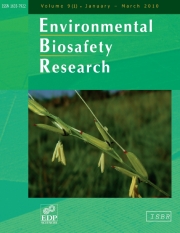Article contents
Information tools for environmental risk assessment of lowlevel presence
An introduction to the reviews of the environmental safety ofproteins used in genetically engineered plants
Published online by Cambridge University Press: 30 April 2012
Abstract
Since the first regulatory approval of a genetically engineered (GE) plant was issued in1992, hundreds of additional GE plants, thousands of regulatory decisions and millions oftons of GE grain and seed have been produced. In an increasingly global economy, the grainand seeds move relatively freely across national jurisdictions, but the regulatorydecisions and associated data and analyses do not. Combined with the realities ofagricultural production, this has led to a legal and regulatory challenge due to the lowlevel presence (LLP) of GE grain or seeds that do not have regulatory approvals in thecountry of destination. In order to assist regulators in conducting environmental riskassessments related to LLP, reviews of environmental safety data, including associatedregulatory analyses and decisions, for proteins commonly introduced in GE plants have beenproduced.
Information
- Type
- Editorial
- Information
- Copyright
- © Center for Environmental Risk Assessment, ILSI Research Foundation
References
- 1
- Cited by

